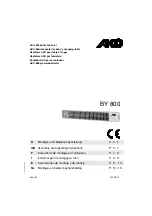
16
17
you wash it by hand do not use
metal scouring pads or abrasive
cleaners, which will scratch
and possibly ruin the finish.
Figure 11
3. To remove stubborn stains and
any discoloration in the interior of
the pressure cooker, try adding
the juice of half a lemon and 1 to
2 cups of water to the pressure
cooker pot. Cook at high pressure
for 15 minutes, then remove
from heat. Let pressure release
naturally, then wash as usual.
4. After cleaning, towel dry with
a clean, soft kitchen cloth to
retain the polished mirror finish.
5. In order to extend the life of the
silicone gasket, remove after
every use and wash with warm
water and mild dishwashing
soap (Fig 19). Rinse and dry well,
then cover with a thin coat of
vegetable oil before replacing.
For increased safety and best
results, the silicone gasket should
be replaced approximately every
12-18 months, depending on
the usage. You can order a
new gasket by calling Fagor
Customer Service Number at:
1-800- 207-0806, or by going
to the online shop section of our
website: www.fagoramerica.com.
Figure 19
6. To store, DO NOT LOCK THE
LID IN PLACE. Simply place
the lid upside down on top of
the pressure cooker pot. This
will avoid the risk of a vacuum
forming inside the cooker during
storage, which would make the
opening of the lid difficult. It will
also prevent stale odors from
forming inside the cooker.
7. Before using the Fagor Chef
pressure cooker, always
check the handles, the base
handle, support grip, and the
lid handle to make sure that
they are securely screwed in
place. If not, tighten the handle
screws with a screwdriver.
8. Replacement Parts: Only use
authentic replacement parts
manufactured and distributed
by Fagor America, Inc. The use
of any unauthorized parts and
or attachments may cause unit
failure and will void any warranty
protection provided by the
manufacturer. You can order
spare parts by calling Fagor
Customer Service Number at:
1-800- 207-0806, or by going
to the online shop section of our
website: www. fagoramerica.com.
.
Cleaning the Operating Valve
After every use, check to make sure
that the operating valve is clear of
any built-up particles.
• To do so, move the operating
valve to the position shown in
Fig. 20 and take out the valve.
Clean it by running water through
it. Next, lift the lid up to the light
and look through the hole under
the operating valve. Make sure
you can see through it and there
are no food particles blocking
it. If necessary, clean it with a
small brush or pipe cleaner.
Figure 20
TO REMOVE THE
OPERATING VALVE FOR
CLEANING PURPOSES:
Move the operating valve to the
pressure release position. Now turn
a little harder to move the operating
valve to the unlock position (picture
of a circle with a line through it).
Pull it gently upwards to remove
it from its socket (Fig.21).
Figure 21
TO REPLACE THE VALVE
AFTER CLEANING
Point the circle with the line through
it to the line with the orange dot.
Place the valve in its socket and
turn it to the right towards the steam
release position. You will hear it
click back into place as you turn
it to the steam release position.
Basic instructions for cooking
In this section you will find basic
instructions for cooking foods which
are most commonly prepared in
pressure cookers. Do not chop or
cut food inside the cooker with a
knife or other sharp utensil to avoid
scratching the bottom. For soups
and stocks, do not fill pressure
cooker over 1/2 full! Remember
to ALWAYS use some cooking
liquid. Operating the cooker without
any cooking liquid or allowing the
cooker to boil dry will damage the
cooker and will not allow it to build
pressure for proper functioning.
Fresh and frozen vegetables
• Wash all fresh vegetables
thoroughly.
• Peel all root vegetables,
CHEF INTERIOR 12-19.indd 16-17
12/19/11 9:14 AM










































